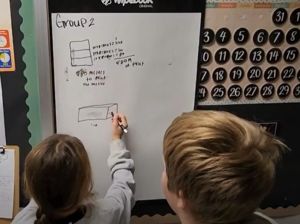1. Rows and columns. Students need to talk about math in order to understand it. They need discourse and can learn from each other as well as from the teacher.
“The smartest person in the room is the room.”
Mary Auger
What Mary means is that Mathematics is a social endeavor. It needs to be talked about and investigated. Students should be checking in with other students about processes and methods and explaining to each other why they did what they did.
It’s not the teacher’s job to have all the answers. It’s their job to give students the tools to find the answers without them.
And it’s not cheating if a student leans over to their neighbor and asks how they got #4, or simply looks over the next group’s work to inform or confirm their own understanding. Get them in groups, get them sharing, talking, discussing, debating, solving, justifying…all the verbs!
When students sit in rows and columns it sends a message to them that they are not going to, and often are not allowed to, talk to each other. It is a receiving arrangement. Watch, listen, copy, mimic. Not good durable learning strategies. Desks and tables in small groups send a message of communication, collaboration, and doing instead of getting. It changes their expectations as soon as they walk in, and in turn, their attitudes.
“Learning mathematics needs to be experiential with students solving problems, sometimes problems they’ve never seen before.”
2. Lecture (sit and get). Students learn better by doing. So do adults for that matter. Research does not support lectures as a good strategy for learning, especially durable learning. Learning mathematics needs to be experiential with students solving problems, sometimes problems they’ve never seen before. Yes, they can learn from those, too!

A better approach to teaching is a flipped gradual release model called You Do, We Do, I Do. Students begin a lesson by working together to solve a problem. The teacher then helps students make connections between their strategies, discussing and guiding the class to the objectives for the lesson. If needed, the teacher can then consolidate the lesson by reviewing the main ideas or introducing new information missed during the lesson. More information can be found at https://www.mixandmath.com/blog/gradual-release-model-teaching-math.
3. Grading everything. There is a myth many teachers believe – “If I don’t grade it, they won’t do it.” It’s simply not true. If teachers struggle with students not turning in homework, not doing anything outside of class, or doing less than their best in class, then they already have proof the statement just doesn’t hold water.
Grades are a judgment that encourage compliance, and compliance is the enemy of learning. Teachers can fix this problem if they stop grading anything that is practice, anything that is part of the learning process. This puts the focus squarely where it’s supposed to be – on the learning. Teachers interested in upgrading their grading practices should look at research like Grading for Equity, by Joe Feldman.
4. Teaching skills first. The traditional arc of teaching is skills then application. It doesn’t work in many cases. When students finally get to the application problems they often fail because they don’t look like the 150 naked problems they just fought over the kitchen table to finish last week. Teaching skills siloed from application does little to develop conceptual understanding needed for problem solving.
Any teacher can get students to solve a proportion for a missing value, but if they don’t know how to recognize a proportional relationship in the wild and know how to set up a proportion to solve, they’re dead in the water. If they don’t understand what a proportion is, then they will struggle to use the concept of proportional reasoning and relationships to solve problems.
“If you want your students to thrive, you have to give them space to become mathematicians and thinkers and doers of math.”
5. Sage on the stage. Calling all control freaks!! If you want your students to thrive, you have to give them space to become mathematicians and thinkers and doers of math. You can’t orchestrate every moment of the class and expect any kind of independence or self-direction to arise at the end. All you’ll create is a bunch of compliant kids who hate math.
Get out of their way and let them learn! Let them use their creativity and solve problems their way. It’s not wrong if they draw a picture instead of writing an equation. If you want them to write the equation, then build that bridge from where they are instead of locking them out of learning until they have your secret password to get into the land of knowledge by learning to do it your way.
We know so much more about teaching and learning than we did even 10 years ago, but much of our teaching practice resembles school of 100 years ago. All it takes is a little courage to make some small changes that result in big improvements!
Resources
Please login or register to claim PGPs.
Alternatively, you may use the PGP Request Form if you prefer to not register an account.



